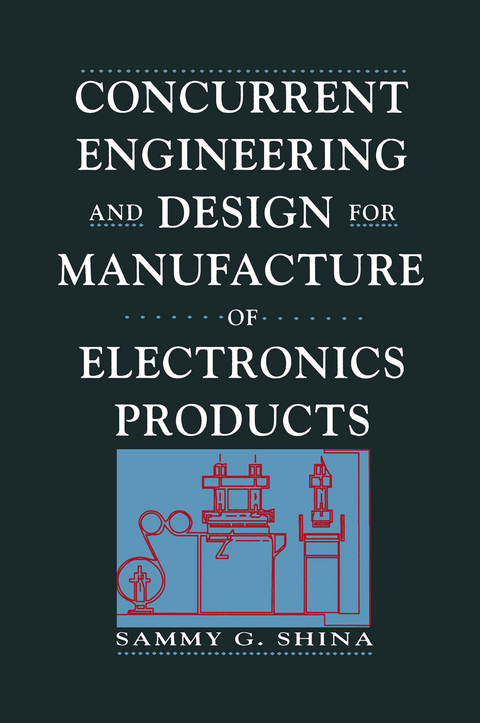
Concurrent Engineering and Design for Manufacture of Electronics Products
Springer-Verlag New York Inc.
9781468465204 (ISBN)
1 Introduction: DFM Concepts.- 1.1 Why concurrent engineering?.- 1.2 Concurrent engineering as a competitive weapon.- 1.3 Using structure charts to describe the process of concurrent engineering.- 1.4 Concurrent engineering strategy and expected benefits to new product introduction.- 1.5 Concurrent engineering results in the introduction of a new electronic product.- 1.6 Conclusion.- Suggested reading.- 2 New Product Design and Development Process.- 2.1 The overall product life cycle model.- 2.2 The role of technology in product development and obsolescence.- 2.3 The total product development process.- 2.4 The design project phases: milestones and checkpoints.- 2.5 Project tracking and control.- 2.6 Conclusion.- Suggested reading.- 3 Principles of Design for Manufacturing.- 3.1 The axiomatic theory of design.- 3.2 The design guidelines.- 3.3 A DFM example: The IBM Proprinter.- 3.4 Setting and measuring the design process goals.- 3.5 Conclusion.- References and suggested reading.- 4 Product Specifications and Manufacturing Process Tolerances.- 4.1 The definition of tolerance limits and process capability.- 4.2 The relationship between manufacturing variability and product specifications for new products.- 4.3 Manufacturing variability measurement and control.- 4.4 Setting the process capability index.- 4.5 Conclusion.- Suggested reading.- 5 Organizing, Managing, and Measuring Concurrent Engineering.- 5.1 Functional roles in concurrent engineering: Design, manufacturing, marketing, quality, and sales.- 5.2 Design guidelines.- 5.3 Organizing for concurrent engineering.- 5.4 Measuring concurrent engineering.- 5.5 Conclusion.- Suggested reading.- 6 Robust Designs and Variability Reduction.- 6.1 On-line and off-line quality engineering.- 6.2 Robust design techniques.- 6.3 Robust design tool set.- 6.4 Use of robust methods in engineering design projects.- 6.5 Conclusion.- Suggested reading.- 7 Customer-Driven Engineering. Quality Function Deployment.- 7.1 Introduction.- 7.2 Quality function deployment.- 7.3 QFD and design systems.- 7.4 The four phases of QFD.- 7.5 Quality function deployment case study.- 7.6 Conclusion.- 7.7 Glossary of QFD terms.- Suggested reading.- 8 The Manufacturing Process and Design Ratings.- 8.1 The manufacturing process for electronic products.- 8.2 Design ratings for manual assembly.- 8.3 Design for automation and robotics.- 8.4 Examples of design for manufacture efficiency.- 8.5 Conclusion.- Suggested reading.- 9 Geometric Dimensioning and Tolerance Analysis.- 9.1 GDT elements and definitions.- 9.2 Cylindrical tolerance zones.- 9.3 Datums.- 9.4 MMC, LMC, and RFS.- 9.5 Controls.- 9.6 Feature control frame.- 9.7 Tolerance analysis.- 9.8 Tolerance analysis case study.- 9.9 Conclusion.- Suggested reading.- 10 Design for Manufacture of Printed Circuit Boards.- 10.1 Printed circuit design.- 10.2 DFM program requirements.- 10.3 Performance measures.- 10.4 Overall process.- 10.5 Conclusion.- Suggested reading.- 11 Reliability Enhancement Measures for Design and Manufacturing.- 11.1 Product reliability systems.- 11.2 Design tools and techniques for enhancing reliability.- 11.3 Product testing for enhancing reliability in design and manufacturing.- 11.4 Defect tracking in the field.- 11.5 Summary.- Suggested reading.- 12 Tools for Dfm: The Role of Information Technology in DFM.- 12.1 Information technology’s role in DFM.- 12.2 Information technology requirements for DFM.- 12.3 Planning the implementation of technology to support DFM.- 12.4 Implementing DFM technology.- 12.5 Lessons learned.- 12.6 Conclusion.- Referencesand suggested reading.- 13 Knowledge-Based Engineering.- 13.1 Limitations of traditional CAD systems.- 13.2 Knowledge-based systems.- 13.3 Design example: plastic mold design.- 13.4 Summary.- Appendix A.- References and suggested reading.
| Zusatzinfo | 250 p. |
|---|---|
| Verlagsort | New York |
| Sprache | englisch |
| Maße | 152 x 229 mm |
| Themenwelt | Sachbuch/Ratgeber ► Natur / Technik ► Garten |
| Informatik ► Theorie / Studium ► Algorithmen | |
| Informatik ► Weitere Themen ► Hardware | |
| Technik ► Elektrotechnik / Energietechnik | |
| Technik ► Maschinenbau | |
| ISBN-13 | 9781468465204 / 9781468465204 |
| Zustand | Neuware |
| Informationen gemäß Produktsicherheitsverordnung (GPSR) | |
| Haben Sie eine Frage zum Produkt? |
aus dem Bereich


